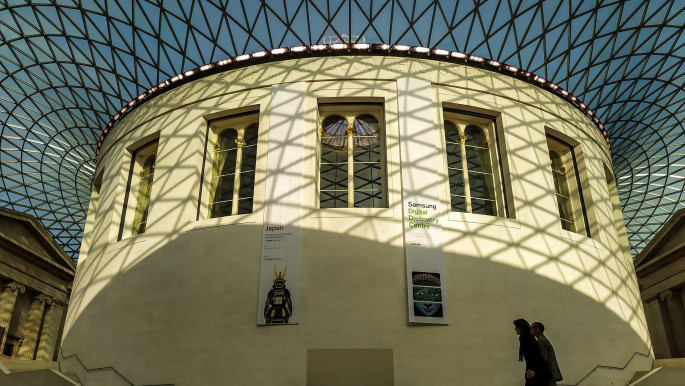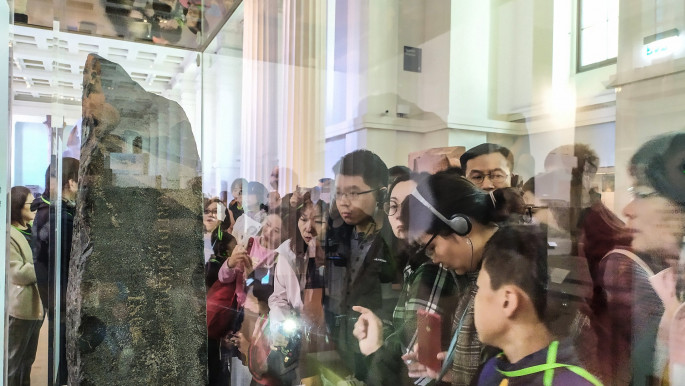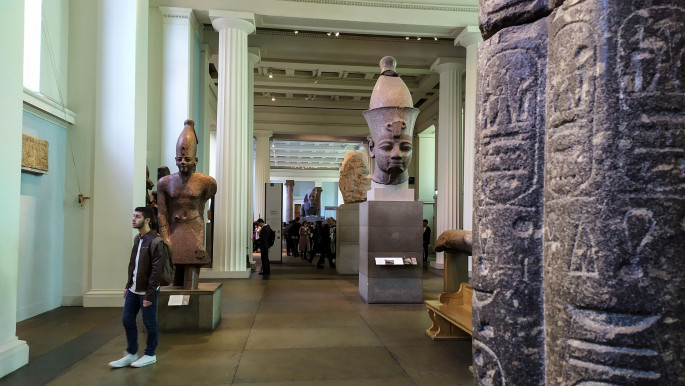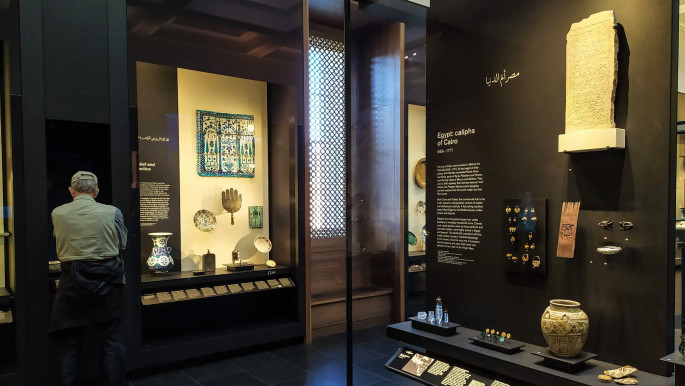The nuances of repatriation: Should the British Museum return its Egyptian collection?
Tour leaders have their flags hoisted high and are chattering softly into their microphones, leading their followers through the gallery and inevitably crowding around the iconic Rosetta Stone.
The Egyptian section of the British Museum is incredibly popular, and is visited by the largest proportion of the six million visitors the institution receives every year. But more and more visitors are asking questions about how these objects arrived here, and why they remain.
A growing number of visitors are aware of the debates surrounding the Museum regarding the origins of these objects, and calls for their repatriation have recently been amplified.
It was one of the issues that Ahdaf Soueif, the prominent Egyptian novelist, who resigned as a trustee of the British Museum, cited as her unhappiness with the way the Museum has addressed questions about its colonial identity.
Today's perspective of history is very reductive, says Dr Neal Spencer, the Keeper of the Nile Valley and Mediterranean Collections at the British Museum, and is emblematic of the information age we live in. He blames social media for turning the issue of repatriation of cultural heritage into black or white arguments.
"I think particularly in the media and social media, there's the sense that everything in the British Museum is stolen; there's actually a very complex array of ways that things came into the British Museum."
 |
|
| The famous Great Court of the Museum was opened to public in 2016 [Getty] |
The repatriation of heritage has been making headlines over the last several months, a debate that was rekindled when French President Emmanuel Macron announced last November that France would return objects that were taken from their colonies in Africa.
Culturally significant items from hundreds of communities around the world today line the shelves of the British Museum, the most visible legacy of a brutal colonial past showcased by the display of foreign heritage as trophies in a collection.
The British Museum is far from alone in this, but it is the best known such collection in Britain, and arguably in the Western world. It contains over eight million objects, of which some 80,000 (1 percent) are on permanent display.
A significant proportion of these come from Egypt.
 |
|
| Crowds of tourists jostle to get a picture of the famous Rosetta Stone, a piece of stone that held the clue to deciphering hieroglyphics [Getty] |
Historically coveted by both Asian and European powers, Egypt's geographic position made it desirable to would-be conquerors. Its indigenous culture, religion, and civilisation have been the subject of much speculation for hundreds of years.
Having either been home to, or dominated by the Greeks, the Romans, the Umayyads, the Fatimids, the Abbasids, the Mamelukes, the Ayyubids, the Ottomans, the French and the English, precious items have been moved around the region for centuries.
The French and English occupation of the country began the modern wave of interest in Egyptian antiquities that led to several expeditions to unearth the country's secrets. While there is no doubt that some of the most significant studies were done by these international archaeological teams and expanded our understanding of this ancient civilisation, it also led to the removal of thousands of objects from the country that have found their way into Western museums.
Boasting the largest collection of Egyptian objects outside of Egypt, the British Museum is home to more than 50,000 Egyptian artefacts, including the Rosetta Stone, a 5000-year-old mummy, and sculptures of Ramses II.
By far the most popular part of the British Museum, Spencer says, is that it draws the majority of the six million visitors to the institution each year.
Diving into the data on these objects reveals several significant stories.
 |
|
| Source: British Museum collection online. Note: While there are over 50,000 items in the British Museum, only around 38,000 are precisely dated |
The British Museum was founded in 1753 and opened to the public in 1759. There were already a small number of Egyptian antiquities in the collection then, and that has since grown to hold more than 50,000 objects.
The dates of acquisition were available for around 38,000 objects (70 percent of the collection), and give very useful overview on the growth of the Egyptian collection.
The vast majority of Egyptian antiquities that arrived in the Museum came when Egypt was a British colony from 1882 to 1956, which is when more than a third of the items were registered.
Apart from the obvious inference that European agents stole the items they fancied (like they did in India, Ethiopia, and in most other colonised countries), it reflects the growing interest in exploring Egypt.
Hundreds of archaeologists, explorers and adventurers from across Europe travelled to Egypt during this period, and new discoveries were carted back home to either be studied, sold, or to form part of their own collections.
The greatest number of acquisitions were made in the first decade of the 20th century, when 7,406 objects were acquired by the British Museum between 1900 and 1910.
In 1904, 2,160 items were received alone, which was the largest acquisition of Egyptian objects.
The French Egyptologist Auguste Mariette contributed most of the objects to the Museum in this period. As the founder of the museum in Bulaq in Cairo (the precursor of today's Egyptian Museum), it is strange that over a thousand of the objects he excavated ended up in different museums in London just 23 years after his death.
 |
|
| A tourist walks through the Egyptian sculpture gallery in the ground floor of the British Museum [Getty] |
The largest number of Egyptian objects were acquired through Rev. Greville John Chester, a British clergyman, collector and author. Chester devoted the latter part of his life to travelling around Egypt and the Levant, and "collected many antiquities in his almost annual travels, including some major pieces" for the British Museum and other such museums, according to the Museum's website.
The second biggest chunk of the collection came from the Egypt Exploration Fund, a fund that was created to explore, survey, and excavate antiquities in Egypt. The British Museum is a major sponsor, according to Spencer, which is why it received tens of thousands of objects over the past two and a half centuries.
The vagaries of the activities of people and organisations like Rev. John Greville Chester and the Egypt Exploration Fund is why there is so much scepticism surrounding the British Museum's collection.
The conditions under which objects were removed from Egypt (and other parts of the world) have never been made clear, which has led many to believe that they were taken illegally.
Objects from Egypt undoubtedly arrived under various legal circumstances, sometimes taking several stops along the way as part of other collections. Some were taken with prior permission and others were gifts, but it is hard to argue that this could be the case for anything more than a fraction of the items that were taken under colonial rule.
Colonisers, and especially the British, have a history of picking up anything they thought was valuable, like the ring and sword of Tipu Sultan from India or the Parthenon friezes from Greece. While not explicitly stated, it is hard to believe that the majority of these items weren't stolen, or at least taken without prior permission of any authority.
It is important to remember that the British Museum was founded during a time of colonisation, when the colonisers undoubtedly looted and pillaged indigenous societies. And the stealing continues today, with smugglers selling Egyptian heritage overseas because it is so highly prized by museums and collections alike.
In July this year, the auction house Christie's announced that they were auctioning a bust of the Egyptian Pharaoh Tutankhamun, which the Egyptian government first requested to be returned to Egypt, and then decided to sue the auction house as it believes the bust is stolen property.
Also this year, the Metropolitan Museum of Art in New York returned a golden coffin to Cairo once US investigators determined it was a stolen artefact.
But often, museums do not or cannot disclose whether an object was acquired legally. The difficulty arises with the British Museum as well, as it is impossible to differentiate between the items that were acquired legally and illegally.
This has led some activists to view the entire collection as "stolen", stating that the burden of proof is on the Museum to prove it's legality.
 |
|
| Islamic art, architecture and culture developed greatly under various civilisations in Egypt, the most notable of which were the Fatimids who founded Cairo in 969 AD [Getty] |
The outspoken archaeologist and former minister of antiquities for Egypt, Dr Zahi Hawass, has long called for the repatriation of stolen heritage. He accuses Western museums of continuing their imperialistic practices by purchasing stolen artefacts and refusing to return them to their country of origin.
Hawass has claimed that 60 percent of Egyptian objects were taken out of the country illegally, and has asked for them to be returned, along with five iconic pieces, including the Rosetta Stone from the British Museum.
At the same time, he does acknowledge that many Egyptian objects did leave the country legally, and he does not ask for those to be returned.
"You have to know that antiquities were sold in Egypt until 1983. They could be taken out to the country, [and so] many objects left Egypt legally. Also, the foreign expeditions working in Egypt take 50 percent of what they discover."
Proponents of the Museum further argue that antiquities – whether stolen or not – should remain in the Museum simple because it is better equipped to study, conserve, and display delicate antiquities, they claim. Hawass calls this a "bullshit" argument, summarily dismissing them.
"Egypt has as good and better museums like anywhere else in the world," he says, and asserts that the Grand Museum in Giza, due to open next year, will be better than most Western museums.
Others say that this line of reasoning further propagates the racist idea that Western culture is stronger and better than any others.
"[It is a] patronising and arrogant idea that somehow the British Museum is better placed to tell the stories of these objects," said Danny Chivers, an environmental writer, consultant and activist with BP or Not BP.
"The communities from where these objects came are in a far better position to tell the real stories of these objects and artefacts, and do so in a way that isn't using the weird, rose-tinted vision of the British Empire."
 |
[The collection] is not owned by the government, nor is it owned by the British Museum. It's owned by the public, it's held in trust by the trustees of the British Museum |  |
The events of the last several months following President Macron's pledge to return stolen African artefacts have brought this issue back in the public eye, but it did not seem to have a major effect at the British Museum.
Soueif's resignation in July this year was another alarm bell that should alert the curators and trustees that this is one issue that they will find very hard to ride through.
As one of the leading cultural institutions in the world, the Museum has not taken any concrete steps to address the questions surrounding the legitimacy of its collection.
Or perhaps their actions simply haven't become widespread knowledge, argues Spencer. While he acknowledges that these are important questions, he says that the British Museum works with foreign indigenous cultures to better understand parts of the collection, provides the infrastructure for communities to launch their own heritage centres like in Sudan, and runs an international training programme that brings together a network of curators, archaeologists, historians and scholars.
"I think we are engaging with [the question of repatriation], and we spend a lot of time thinking about it, how we deal with it, how we work together with different countries and institutions, and perhaps that hasn't necessarily had the public profile it needs to, and that's something we're looking at."
He does not, however, think the Museum has a moral responsibility to return objects to their cultural homelands.
"We're very open to lending objects, including on long term loans. I mean, they don't have to be for three months exhibition. […] there are objects that we have on loan elsewhere around the world that have been there for years and years and years."
He also adds that there is a piece of legislation preventing the British Museum from returning any objects. The British Museum Act of 1963 forbids the Museum from removing any object in its collection, except in a few very select cases.
"The legal basis for the British Museum means objects can't be disposed of or be removed from the collection," says Spencer. "What we can do is lend objects, and we lend 5,000 objects a year around the UK and around the world.
"[The collection] is not owned by the government, nor is it owned by the British Museum. It's owned by the public, it's held in trust by the trustees of the British Museum."
Hawass claims to have asked the Museum to borrow the Rosetta Stone for the opening of the Grand Museum, but never received a reply. Spencer contradicts this claim, and says that the Museum has never had any requests from Egypt for Egyptian objects on loan.
 |
It's a conversation that needs to be entered into with an open mind and with a will to explore the past and the future |  |
All of these arguments have made repatriation an increasingly polarising conversation, especially online, when it is in fact full of caveats and nuances that need to be considered.
There is no doubt that the British Museum does a fantastic job of showcasing and preserving heritage in context with the wider history of our world, but at the same time, it displays its objects like trophies from vanquished enemies.
So where do we go from here? Perhaps Ahdaf Soueif's reasons for resigning from the Board point us in the right direction.
"On the issue of restitution," she says, "there is no 'one-size-fits-all' solution, it has to be a case-by-case deliberation, and the 'solutions' stretch across the whole spectrum – from the object remaining where it is in the 'colonial' museum but is provided with an appropriate context, to the object returning to the location where it was made – with lots of varied possibilities in between."
She also argues that a "global conversation" needs to be encouraged not just about the ownership of cultural property, but about the power dynamic between the global north and the global south and how it affects this question of heritage.
"It's a conversation that needs to be entered into with an open mind and with a will to explore the past and the future."
Spencer is aware that the Museum needs to do more, and is optimistic it can address these concerns adequately. He is cognizant of the need to decolonise the collection, and implied that the issues will be addressed when the institution re-displays in entire collection over the next two decades or so, a project in which the Museum "very much want[s] to involve people from around the world."
 |
|
| A tourist takes a picture of a false door from Egypt's Old Kingdom that dates back to around the 25th century BC [Getty] |
One can only hope that the Museum takes the criticism it has received from inside and outside its walls to make a genuine effort to decolonise its collection.
The repatriation debate is in many ways a microcosm of the power dynamics between the colonised world and the colonisers, one where the global north has rarely taken responsibility for its actions that destroyed the lives of millions around the world.
Countries that were ravaged by colonisation have begun understanding the significance of the heritage they have lost, and are asking for it to be returned to its geographical homeland.
After destroying the lives and breaking the economies of places like Egypt, the least the UK and other former colonisers can do to atone for their deeds is to have this conversation, decolonise their collections and return stolen property.
The British Museum has the opportunity to lead the way in this regard. As one of the most powerful cultural institutions, it has the resources to find the right balance between returning objects and continuing to be a world class museum.
Governments, experts and academics are slowly coming to terms with this; Britain and the British Museum must follow suit, or be left behind.
Ali Abbas Ahmadi is a digital journalist. Follow him on Twitter: @AliAbbasAhmadi2



